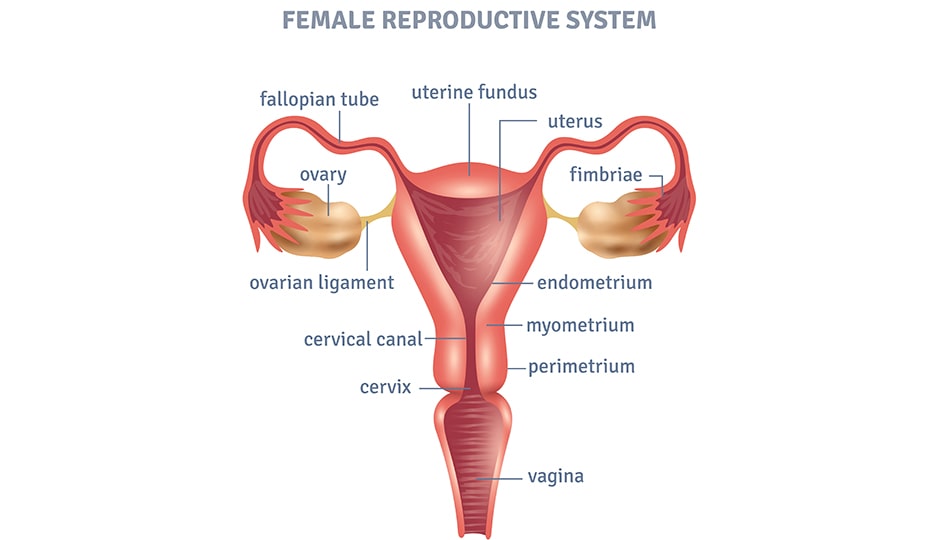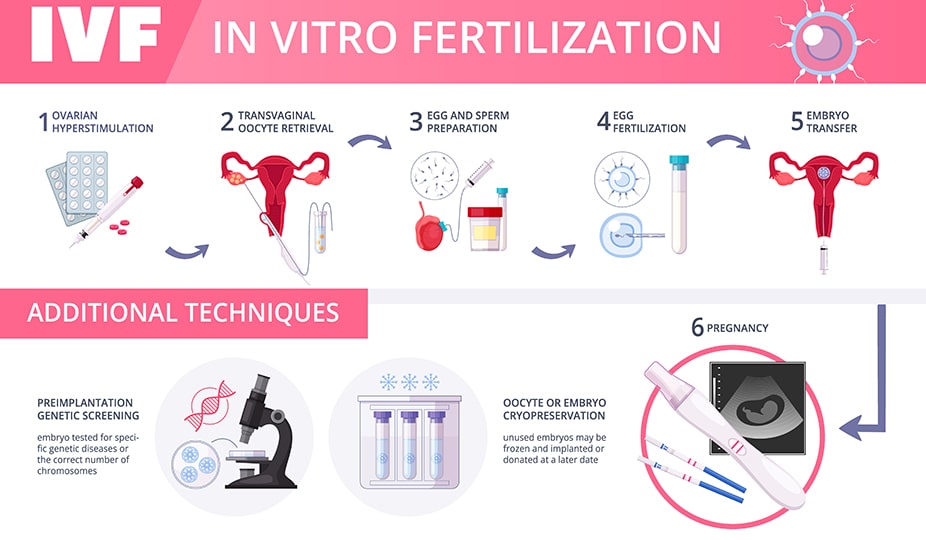Fallopian Tubes Blockage – Symptoms, Causes, and How to Get Pregnant
Today, fallopian tubes blockage is one of the most common causes of female infertility. This condition does not allow the couple to have a baby in 20-25% of cases. The fallopian tubes’ obstruction creates conditions that are unfavorable for conception. It interferes with the movement of the egg. Considering that natural fertilization takes place in the fallopian tubes, in case of blockage, the oocyte cannot meet spermatozoa, and conception becomes impossible. However, as far as technologies grow, there are several surgical and conservative ways to resolve the issue.

That’s why, in this post, we will dig deeper into the fallopian tubes blockage causes, symptoms, and treatments that lead to a successful pregnancy.
What Is Fallopian Tube Blockage?
The fallopian tubes are the hollow organs through which the egg moves from the ovary to the uterine cavity. This process works via peristalsis. The epithelium cilia, which lines the tubes, move towards the uterus and lead the mature oocyte to meet with sperm.
The tubal obstruction causes infertility. This factor estimates about half of the impaired fertility cases. Another danger related to partial fallopian tubes blockage is the risk of ectopic pregnancy when the fertilized egg cannot move to the uterus. It starts to develop and grow inside the tube.
The fallopian tube obstruction is often asymptomatic. Most often, women start the examination only when they can`t get pregnant naturally. First of all, a gynecologist tests the ovulation and spermogram. The second stage is the examination of the fallopian tubes. If a doctor defines the tubal-peritoneal factor, it is crucial to make further investigations to determine its most likely causes.

If you have issues with natural conception, don`t hesitate to consult the gynecologist as soon as possible. Conservative treatment is efficient only at the very beginning of the pathological process. It is possible to stop inflammation and lyse the tubal adhesions via surgery. It is a microsurgical operation that leads to the most accurate restoration of the tubal anatomy. If this measure fails and the pregnancy doesn`t start naturally, specialists recommend women to use IVF.
Types of Fallopian Tubes Blockage
There are two types of fallopian tubes blockage:
- full – the lumen of the fallopian tubes is wholly blocked;
- partial – there is minimal patency of the fallopian tubes.
Tubal obstruction can be one or two-sided form. In the latter case, the prognosis of fertility is unfavorable – as a rule, pregnancy can not do without IVF.
Considering the causative factor, obstruction of the fallopian tubes is of the following types:
- inflammatory – exudate and intraluminal adhesions cause impaired patency;
- postoperative – fallopian tubes are compressed with adhesions from the outside after cavity interventions, or from the inside after curettage;
- endometrioid – at the beginning of its growth the endometrium clogs the lumen, in addition to this, connective tissue constrictions can form;
- functional – the lumen is not blocked, but the egg does not move, because there is no peristalsis of the tube (more often associated with hormonal causes).
Depending on the prevalence of the pathological process, there are 4 degrees of the fallopian tube blockage:
- 1st degree – the fallopian tube is passable, the folding is standard, but there are minimal adhesions on the appendages.
- 2nd degree – impassable section of the fallopian tube is adjacent to the ovary; the folding is average, and adhesions cover less than half of the ovarian surface.
- 3rd degree – impassable section of the fallopian tube is adjacent to the ovary; mucosal folds are destroyed and surround more than half of the ovarian surface.
- 4th degree – liquid fills the lumen of the fallopian tube; the folds are destroyed, adhesions almost wholly cover the ovary.
Fallopian Tubes Blockage Symptoms
Fallopian tubes blockage symptoms are absent in most of the cases. Even if there is an inflammatory process, women hardly can notice any changes in their health. Nonspecific signs of the disease can appear only with severe exacerbation. The symptoms are:
- pain in the lower abdomen;
- bloating, constipation or, conversely, diarrhea;
- menstrual irregularities;
- frequent urination;
- pain during sexual intercourse.
Causes of Fallopian Tubes Blockage

The leading causes of the fallopian tube blockage are:
- sexually transmitted infections leading to inflammatory diseases of the uterus;
- genital tuberculosis;
- invasive procedures – X-ray examination of the uterus and fallopian tubes;
- dilation and curettage of the endometrium;
- abortions;
- endometriosis of the fallopian tubes.
In 60% of cases, obstruction of the fallopian tubes is caused by inflammatory processes. As a result, ciliary epithelium destructs, which leads to the agglutination of fimbriae and its scarring. The organ deforms, there are saccular protrusions, which get filled with fluid (hydrosalpinxes). The fertilized egg cannot move to the uterine cavity is disrupted. If the tubes are partially clogged, it increases the risk of ectopic pregnancy, in case of complete blockage, it leads to tubal infertility.
Fallopian Tubes Blockage Diagnostics
The main methods that allow you to identify the obstruction of the fallopian tubes are as follows.
- X-ray Hysterosalpingography is a contrast image of the uterine cavity and fallopian tubes. A woman should make it in the second part of the menstrual cycle (day 19-21).
- Ultrasound contrast hysterosalpingography is the most preferred method of diagnostics. The doctor introduces sterile fluid into the uterine cavity and evaluates the nature of its entry into the abdominal cavity through the fallopian tubes is evaluated. The study takes place in the first phase of the cycle (day 7-10).
There are additional possible examination methods. First and foremost, a woman should make tests for genital infections to exclude chlamydia and gonorrhea. It is also essential to check the hormonal profile and perform an ultrasound check of the pelvic organs.
Fallopian Tube Blockage Treatment
Conservative or surgical treatment may be used depending on the blockage type. Sometimes the pregnancy is impossible without assisted reproductive techniques.
Fallopian Tube Blockage Treatment without Surgery
Conservative treatment can work only in the early stages of the inflammatory process. If most of the ciliary epithelium is healthy, doctors can prescribe anti-inflammatory and antimicrobial medicines to treat the infection, and enzymes that accelerate the lysis of soft adhesions.
In the case of endocrine status disorders, doctors also prescribe hormone therapy to increase fertility.
Fallopian Tube Blockage Surgery
Surgical treatment is carried out according to the following indications:
- compression of the fallopian tube from the outside;
- endometriotic heterotopies combined with hormonal therapy;
- cicatricial deformities.
In modern gynecology, surgeons make laparoscopic interventions. It allows accessing the pelvic organs through 3 small punctures in the anterior abdominal wall. As a result, the procedure can restore the correct anatomy of the fallopian tube. The scope of intervention may be as follows:
- separation of adhesions;
- separation of fimbriae;
- surgery of separate tube segments.
Microsurgical instruments minimally injure the tissues and can restore the organ structure to the smallest detail.
After the microsurgical intervention, patients take drugs to induce ovulation, e.g., Clomiphene, Clomid, Tamoxifen, Letrozole.
Assistive Reproduction and IVF

In most cases, especially with III-IV degree of obstruction of the fallopian tubes, if a woman over 35 years old and has a long history of infertility, the only way to get pregnant is in vitro fertilization with embryo transfer. Assisted reproduction is the solution if natural pregnancy does not start within 6-12 months after surgery.
Prevention and Rehabilitation
The main measures to prevent the fallopian tube blockage are:
- protection against sexually transmitted infections;
- timely detection and treatment of inflammatory processes of the pelvic organs;
- reliable contraception to avoid abortion as a method of birth control;
- laparoscopy, rather than open abdominal surgery, if necessary, surgical treatment of a particular pathology.
The minus of surgical intervention is the continuing risk of scarring. Therefore, women need rehabilitation after surgery. At the recovery stage, physiotherapy procedures, as well as enzyme medications, are used. They help to prevent the formation of repeated adhesions.
The operation to eliminate obstruction of the fallopian tubes is considered successful if the uterine pregnancy occurs within 6-12 months. If this does not happen, the gynecologists recommend IVF.

Expert Opinion
“Obstruction of the fallopian tubes requires the earliest possible diagnostics. On the one hand, the longer this pathological process exists, the more changes in the organ`s structure it brings. On the other hand, the effectiveness of the IVF treatment directly depends on the woman`s age. Success chances are higher in young patients.
As a rule, fallopian tube blockage does not hurt, except intense inflammation. Therefore, in most cases, the only symptom is the impossibility of conception. If pregnancy does not occur within 12 months, consult a gynecologist to determine the reasons. 35+ y.o. Women should not wait for more than 6 months. “
Vladimir Yakovenko, IVF Expert
Frequently Asked Questions
The gynecologist can define the problem and lead the treatment.
There are no specific clinical signs. The risk of this condition increases after surgical interventions on the pelvic organs, inflammations, repeated curettage of the uterine cavity. The examination usually begins due to infertility. Gynecologists recommend either an X-ray or ultrasound estimation of the tubal patency.
There are two main risks – infertility and ectopic pregnancy. In the case of inflammatory genesis, a periodic exacerbation may occur, which predisposes to the formation of purulent tumors in the appendages.
After a detailed examination, the gynecologist selects an optimal treatment. If there is an active inflammatory process, then it can be treated with medications. In all other cases, doctors use the reconstructive intervention of the fallopian tubes. If pregnancy does not occur within a year, it is advisable to make IVF.
If a woman does not plan pregnancy at the moment and in the future, and there is also no hydrosalpinx, then you can refrain from treatment. In all other cases, the restoration of fertility involves causative factor elimination. If this is not possible, then IVF is performed.
Final Words
Fallopian tube blockage does not mean infertility. Moreover, early diagnostics and professional assistance can help you resolve the issue in the early stages.
If you are looking for the best clinics or doctors, want to know more about IVF, our specialists can help you find the joy of parenting with the help of modern reproductive techniques. Use free consultancy with our experts; we are always here to help!